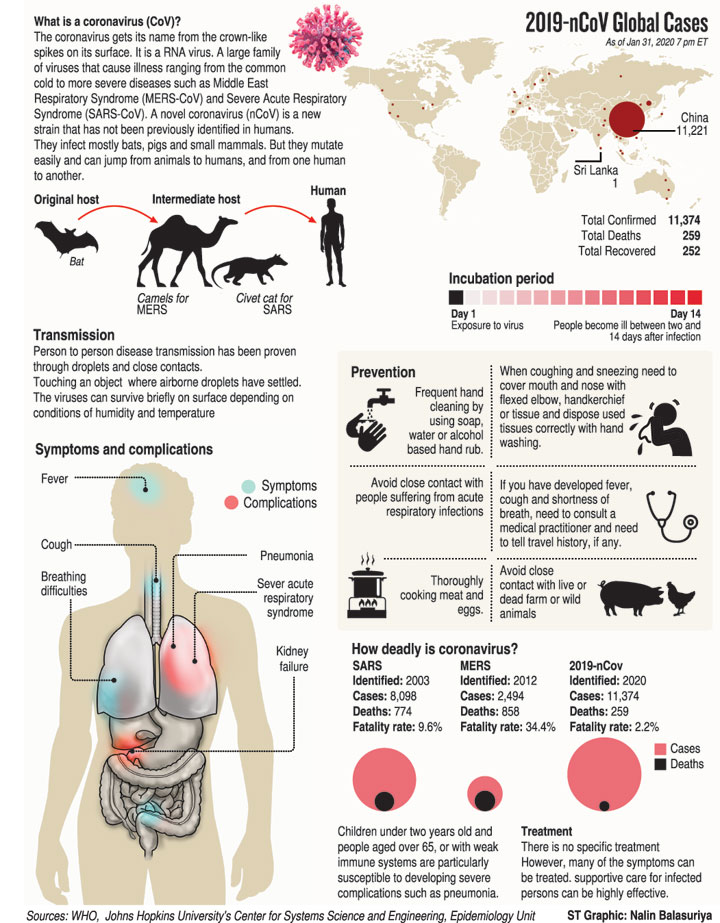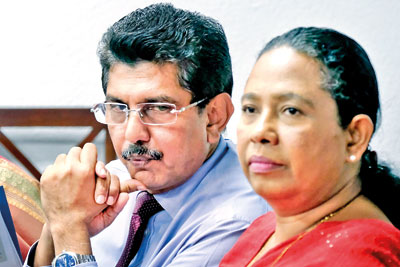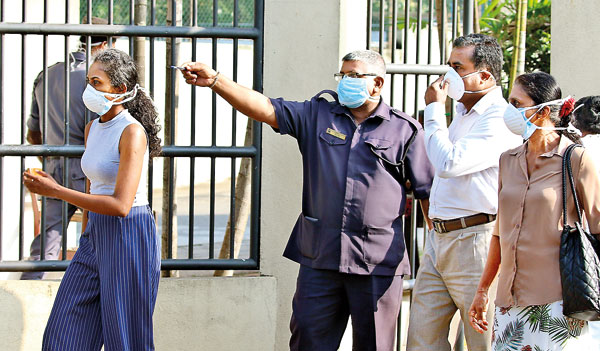News
Don’t let rumour spread faster than coronavirus
Don’t panic, but be vigilant. Act but don’t react. Get information from credible sources, as rumour is spreading faster than the new coronavirus. Sri Lanka has put in place measures to ward off this threat.
These were the key messages with regard to the 2019-novel coronavirus (2019-nCoV) reiterated by health authorities, as a rational voice in the form of former Chief Epidemiologist, Dr. Nihal Abeysinghe who guided the country through the Severe Acute Respiratory Syndrome (SARS) period underscored the importance of having “centralized coordinated surveillance” when dealing with an “unknown” infection. Sri Lanka was able to keep SARS from reaching the country.
As Sri Lanka detected its first ‘imported’ case of 2019-nCoV (a Chinese woman tourist) on Monday (January 27); the World Health Organization (WHO) on Thursday declared a Public Health Emergency of International Concern (PHEIC) and the 33 Sri Lankans from the locked down city of Wuhan were brought back to the Mattala Rajapaksa International Airport.
The week saw a flurry of activity in the form of several media briefings by health authorities, daily updates from the Health Ministry and social media going on the rampage spreading false information and people in a panic rushed to buy surgical face-masks.
The Sri Lankan health authorities responded by allaying fears and keeping the public informed of the measures in place, with many earnest appeals not to let fear cause xenophobia against the Chinese and also stigmatization.
The Chinese tourist detected with the nCoV is recovering, assured the Director-General of Health Services, Dr. Anil Jasinghe at a media briefing at the Health Ministry on Friday afternoon, giving details of other ‘suspected’ cases in hospitals which he believed were 99.9% not 2019-nCoV.
There are 9 suspected cases at the National Institute of Infectious Diseases (NIID), Angoda; 4 at the Kandy Hospital; 3 at the Gampaha Hospital; 3 at the Karapitiya Hospital; and 1 at the Ratnapura Hospital, it is learnt.
Currently the NIID, the Kandy National Hospital, the Kalubowila, Karapitiya, Anuradhapura, Jaffna, Kurunegala and Batticaloa Teaching Hospitals, and the Gampaha, Negombo, Ratnapura and Badulla Hospitals are the designated hospitals.
Dr. Jasinghe pointed out that the WHO had not seen the need yet for a travel and trade embargo. Countries cannot take arbitrary decisions on their own to impose such measures. If they do so, they first have to justify to the WHO why such action is necessitated, as part of the International Health Regulations (IHR), he said, adding that in fact the WHO had commended the measures implemented by China with regard to the 2019-nCoV.
Some health sources, however, cautioned that Sri Lanka “must” stop the entry of the virus from all entry points, not only the Bandaranaike International Airport, Katunayake.
If the 2019-nCoV comes into the country, it will spread like wildfire as it is a respiratory disease. Our hospitals however efficient they are will not be able to manage the influx of patients, the sources said.
Whether designated or not to meet the emergence of this threat, all hospitals have to be prepared to face it with strict protocols and equipment in place, urged these sources, adding that infection control needs to be given priority.
Other sources indicated that the efficiency of designated hospitals would depend on the capability of the leadership.
The protocols in place not only at the airports and the port but also in hospitals have to be checked regularly, one source urged, calling for regular audits as staff could become lax after awhile.
Elaborating on measures taken, Dr. Jasinghe said that adequate stocks of Personal Protective Equipment (PPE) costing Rs. 60 million which includes clothing and goggles etc to protect the health staff from infection have been distributed to hospitals. The WHO and UNICEF have also offered assistance with regard to securing more PPEs. The Health Ministry was also in constant communication with the Directors of those hospitals about urgent needs.
Referring to why the WHO had declared a PHEIC, the Director-General said:
n Globally, some countries have strong and others weak health systems. If some of the countries which had weak systems but had close links with China such as some African countries were affected by the 2019-nCoV there could be a crisis in those countries.
n In the light of there not being specific treatment and vaccine yet for this new virus, the declaration was made to propel the world to work towards finding a treatment and vaccine.
n It was also to get big donors to get activated to fund such endeavours.
Dr. Jasinghe stressed that people should not be misled by myths and rumour being spread through social media and asked that they check the authenticity and veracity of claims with the right authorities.
Hotlines
The 24 – hour hotlines for information are: 071 0107 107 and 011- 3071 073

Preventive measures in place at all ports of entry
The Sunday Times carried out a detailed check of the preventive measures being taken at all ‘ports of entry’ to Sri Lanka.
Such entry points include the Bandaranaike International Airport (BIA), Katunayake; the Jaffna International Airport, Palali; the Mattala Rajapaksa International Airport; and the Ratmalana Airport and the ports of Colombo, Galle, Hambantota and Trincomalee.
The measures taken at the BIA (where 2,000-3,000 passengers arrive and depart daily) which sees the largest number of passengers coming in are:
· All passengers are shown a video while on the aircraft with a Health Declaration Form (both in English and Chinese) as well as an information leaflet about nCoV and hotline numbers are being distributed to them to be filled and handed over to staff once they land. The form seeks information of recent travel history whether they have come directly from a country or have been in transit.
· Once they leave the flight, they pass through thermal scanners which would indicate whether they have a fever and if so they are checked by the health staff.
· If such passengers with fever have come directly from China or originated their journey in China and have been in transit in another country, they would be checked thoroughly by the health staff at the airport. If there is a high chance that they are carrying nCoV, they would be sent to the National Institute for Infectious Diseases. Otherwise they would be sent to the Negombo Hospital.
· Even if they are not ill, the details of all those who come directly from China or have originated their journey in China but transited elsewhere and their whereabouts and where they will be going to within Sri Lanka are being collated in a database and the relevant Medical Officers of Health (MOHs) in those areas informed to keep track of their movements.

Scene at BIA
Jaffna, Mattala & Ratmalana Airports:
Similar measures as at the BIA but on a smaller scale have been deployed at these airports, it is learnt.
Jaffna gets only three flights per week from Chennai on Monday, Wednesday and Saturday, with each flight generally having about 50 passengers, while Mattala gets around 4-5 flights per week, mainly for re-fuelling. Ratmalana, meanwhile, has only scheduled corporate international flights with around 50 passengers per month coming in.
There is a small health staff at these airports and the capability to screen each and every passenger, it is learnt, while Ratmalana there is hand-held distance-temperature measuring equipment.
When contacted the DDG of Public Health Services, Dr. Paba Palihawadana said that Epidemiology Unit staff are not only calling the staff of the MOH areas to remind them to keep in contact with those who have come into Sri Lanka and are in those areas, but also calling the passengers themselves to find out whether they are unwell, as a double-check.
Next week, Epid Unit staff is hoping to pay field visits to these areas, she added.
When informed that the Sunday Times has received information that some passengers have been missed, she said that they are promptly attempting to fill those gaps by checking passenger lists.

Dr. Anil Jasinghe with Health Minister Pavitra Wanniarachchi at a news conference on Friday
At the ports –
“Health declaration forms and information leaflets are sent in advance to the ships so that they can be filled out before they dock at any port,” said Dr. Palihawadana, stressing that doctors also board the ships to check whether anyone is ill.
Ships can also signal the port beforehand using their flag system to let the port know that someone is ill, she said, while the health authorities are also working closely with the Ceylon Association of Shipping Agents.
We have told all port authorities to be extra-vigilant, she added.
The Colombo Port gets about 1,000 passengers per day; no passengers alight at Galle Port, only crew (about 50-60 per day) in cargo ships; no passengers have arrived at the Hambantota Port in the last month and no ship crews are going out of this port as a precautionary measure against the coronavirus; and the Trincomalee harbour does not get any passengers.
When asked about the two passenger cruise-liners, ‘Queen Mary’ and ‘Bowdice’ (heading this way from the east) due to dock at the Colombo Port with at least 2,500 on board each, Dr. Palihawadana was categorical that all checks would be carried out and not one single passenger would be allowed to disembark if there is suspicion of anyone being ill. Then everyone will be subjected to a thorough screening.
On January 28, the Ports Health Authority had briefed all staff about the coronavirus.

Scene at IDH. Pix by Amila Gamage, and Lahiru Harshana
| Centralized coordinated surveillance important Sri Lanka can handle an unknown infection – but it should be done through a centralized coordinated surveillance and a single spokesperson who collects the information from every other source, whether BIA, quarantine unit, army or hospital and is capable of answering every query, underscored former Chief Epidemiologist Dr. Nihal Abeysinghe who was part of the team which faced the threat of the Severe Acute Respiratory Syndrome (SARS) in the early 2000s. It should be the Epidemiology Unit which takes centre-stage and has done so as there is a “time-tested” system in place, he said, giving it as the Department of Health, the Director-General, Deputy Director-General, Provincial Directors of Health, Regional Directors of Health, Medical Officers of Health, Public Health Inspectors (PHIs) and Public Health Midwives (PHMS). This system has handled outbreaks from the plague to polio, from cholera to measles and more. Sri Lanka is the only country in the region which has this strong system. We have had good infrastructure to respond to any public health need since 1926, he pointed out. Systematically, Dr. Abeysinghe analyses the needs of the current nCoV threat. We need to be vigilant for:
The measures needed are: n Appropriate funding for logistical support at crucial institutions such as the Medical Research Institute (MRI) n Traveller screening – mostly at the BIA as there is a rush for passengers jostling to get out and also at sea-ports where health officials can board ships to check for ill passengers. Forms seeking detailed information can be distributed to all passengers. n Strong units consisting of trained public health personnel being deployed at entry points to spot people who are ill. n Enhanced surveillance through the protocols already in place to catch any flu-like disease doing the rounds, with strong follow-up and monitoring. n True public health practice – contact tracing and follow-up and admission to designated hospitals | |

